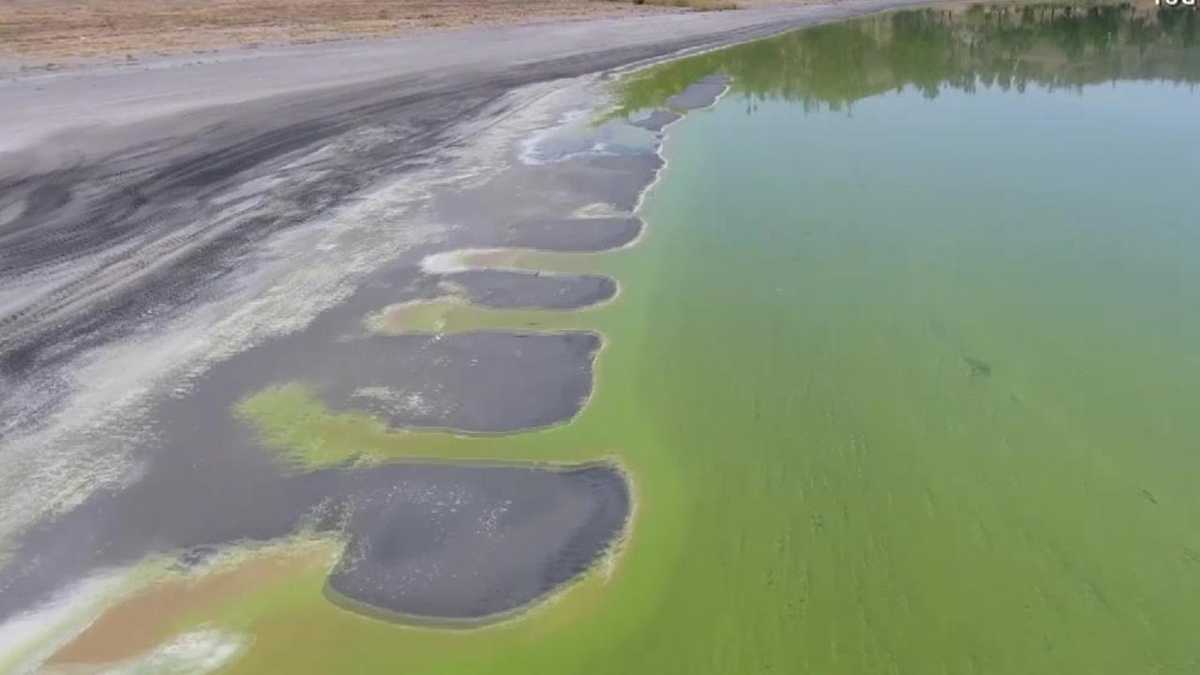Toxic Algae Bloom Threatens California's Coastal Ecosystem

Table of Contents
The Science Behind Toxic Algae Blooms in California
Toxic algae blooms, or harmful algal blooms (HABs), are the result of a rapid increase in the population of harmful algae in aquatic environments. This proliferation is primarily driven by an overabundance of nutrients, specifically nitrogen and phosphorus, coupled with favorable environmental conditions. Understanding the science behind these blooms is crucial to effectively combating them.
- Nutrient Enrichment: Increased agricultural runoff, carrying fertilizers rich in nitrogen and phosphorus, significantly contributes to nutrient enrichment in coastal waters. This excess of nutrients acts as a fertilizer for algae, fueling their explosive growth.
- Climate Change's Influence: Warmer ocean temperatures, a direct consequence of climate change, extend the bloom seasons and create more favorable conditions for HABs to thrive. Changes in ocean currents and upwelling patterns can also exacerbate the problem.
- Harmful Algae Species: Specific types of algae are responsible for the toxicity of these blooms in California waters. Pseudo-nitzschia, a diatom species, produces domoic acid, a neurotoxin. Various dinoflagellates also produce potent toxins such as brevetoxins, causing significant harm.
- Toxic Effects: These algae produce potent toxins like domoic acid (causing amnesic shellfish poisoning), brevetoxins (causing neurotoxic shellfish poisoning), and others. These toxins accumulate in shellfish and other marine organisms, entering the food web and impacting marine life and humans alike.
Impacts of Toxic Algae Blooms on California's Coastal Ecosystem
The detrimental effects of toxic algae blooms on California's coastal ecosystem are far-reaching and devastating. The consequences extend beyond immediate fish kills, impacting the entire marine food web and the economic stability of coastal communities.
- Marine Life Impacts: HABs cause widespread fish kills, contaminate shellfish rendering them unsafe for consumption, and harm marine mammals through toxin ingestion or respiratory distress. Sea lions, whales, and other marine animals have suffered significant mortality events due to HABs.
- Economic Losses: Fisheries closures due to shellfish contamination lead to substantial economic losses for fishing industries. Tourism is also severely impacted, as beach closures and warnings deter visitors from enjoying the coastline.
- Food Web Disruption: The disruption of the food web caused by HABs has long-term consequences for the overall health and biodiversity of the ecosystem. The loss of key species can trigger cascading effects, destabilizing the delicate balance of the marine environment.
- Endangered Species Threats: Several endangered species, including certain types of whales and seabirds, are particularly vulnerable to the impacts of HABs, further jeopardizing their already fragile populations.
Human Health Risks Associated with Toxic Algae Blooms
Toxic algae blooms pose significant threats to human health, primarily through the consumption of contaminated seafood and exposure during recreational activities.
- Seafood Consumption: Consuming shellfish contaminated with toxins like domoic acid can lead to amnesic shellfish poisoning (ASP), characterized by symptoms such as nausea, vomiting, diarrhea, and memory loss. Severe cases can be fatal.
- Public Health Advisories: Regular monitoring and timely issuance of public health advisories and shellfish harvesting closures are essential to protect public health. These advisories are crucial for preventing human exposure to harmful toxins.
- Recreational Exposure: Aerosolized toxins from HABs can cause respiratory irritation and other health problems in individuals engaged in recreational activities such as swimming, boating, and surfing near affected areas.
- Monitoring and Warning Systems: Robust monitoring and early warning systems are vital for detecting HABs early and issuing timely warnings to protect both marine life and human populations. This requires advanced technology and close collaboration between various agencies and researchers.
Mitigation and Management Strategies for Toxic Algae Blooms
Addressing the escalating threat of toxic algae blooms requires a multifaceted approach encompassing preventative measures, improved water quality management, and effective monitoring systems.
- Reducing Nutrient Runoff: Implementing improved agricultural practices to minimize fertilizer use, promoting the use of cover crops, and investing in buffer zones can significantly reduce nutrient runoff into waterways.
- Wastewater Treatment: Investing in upgraded wastewater treatment infrastructure to remove excess nutrients before discharge is crucial for improving water quality.
- Advanced Monitoring Technologies: Developing and deploying advanced monitoring technologies, including satellite imagery, autonomous underwater vehicles, and sophisticated sensor networks, enables early detection of HABs.
- Public Education: Public education campaigns are vital to raise awareness about the risks associated with HABs and to promote responsible behaviors that minimize nutrient pollution.
- Research and Development: Continued research into the causes and effects of HABs is critical for developing more effective mitigation and management strategies.
Conclusion
The escalating threat of toxic algae blooms poses a significant and multifaceted challenge to California's coastal ecosystem. The interconnectedness of environmental, economic, and human health impacts underscores the urgency of addressing this issue comprehensively. Climate change and nutrient pollution are key drivers of HABs, emphasizing the need for long-term solutions that target both factors. The devastating effects of these harmful algal blooms demand immediate and concerted action. We must work collaboratively – governments, researchers, industries, and individuals – to reduce nutrient pollution, improve water quality, and implement effective monitoring and management strategies to protect California's precious coastal ecosystem. Learn more about how you can help mitigate the threat of toxic algae blooms in California and report any suspected blooms to the relevant authorities.

Featured Posts
-
 El Chino Rios Confesion De Un Tenista Argentino Sobre Una Leyenda
May 30, 2025
El Chino Rios Confesion De Un Tenista Argentino Sobre Una Leyenda
May 30, 2025 -
 Laurent Jacobelli Depute Rn Ses Interventions Et Projets De Loi
May 30, 2025
Laurent Jacobelli Depute Rn Ses Interventions Et Projets De Loi
May 30, 2025 -
 Delving Into The Lost Potential A Pacific Rim Sequel Speculation
May 30, 2025
Delving Into The Lost Potential A Pacific Rim Sequel Speculation
May 30, 2025 -
 Measles Why It Persists And How To Combat Its Spread
May 30, 2025
Measles Why It Persists And How To Combat Its Spread
May 30, 2025 -
 Fog Rolling In San Diego County Weather Update With Cooler Temps And Showers
May 30, 2025
Fog Rolling In San Diego County Weather Update With Cooler Temps And Showers
May 30, 2025
Latest Posts
-
 Discounted Spring Hotel Stays Up To 30 Off Lavish Hotels
May 31, 2025
Discounted Spring Hotel Stays Up To 30 Off Lavish Hotels
May 31, 2025 -
 Exploring The Boundaries Of Ai Learning Towards Responsible Ai Development And Deployment
May 31, 2025
Exploring The Boundaries Of Ai Learning Towards Responsible Ai Development And Deployment
May 31, 2025 -
 Responsible Ai Acknowledging The Limits Of Ai Learning Capabilities
May 31, 2025
Responsible Ai Acknowledging The Limits Of Ai Learning Capabilities
May 31, 2025 -
 Exploring The Boundaries Of Ai Learning A Path To Responsible Ai
May 31, 2025
Exploring The Boundaries Of Ai Learning A Path To Responsible Ai
May 31, 2025 -
 Up To 30 Off Your Luxurious Spring Hotel Awaits
May 31, 2025
Up To 30 Off Your Luxurious Spring Hotel Awaits
May 31, 2025
